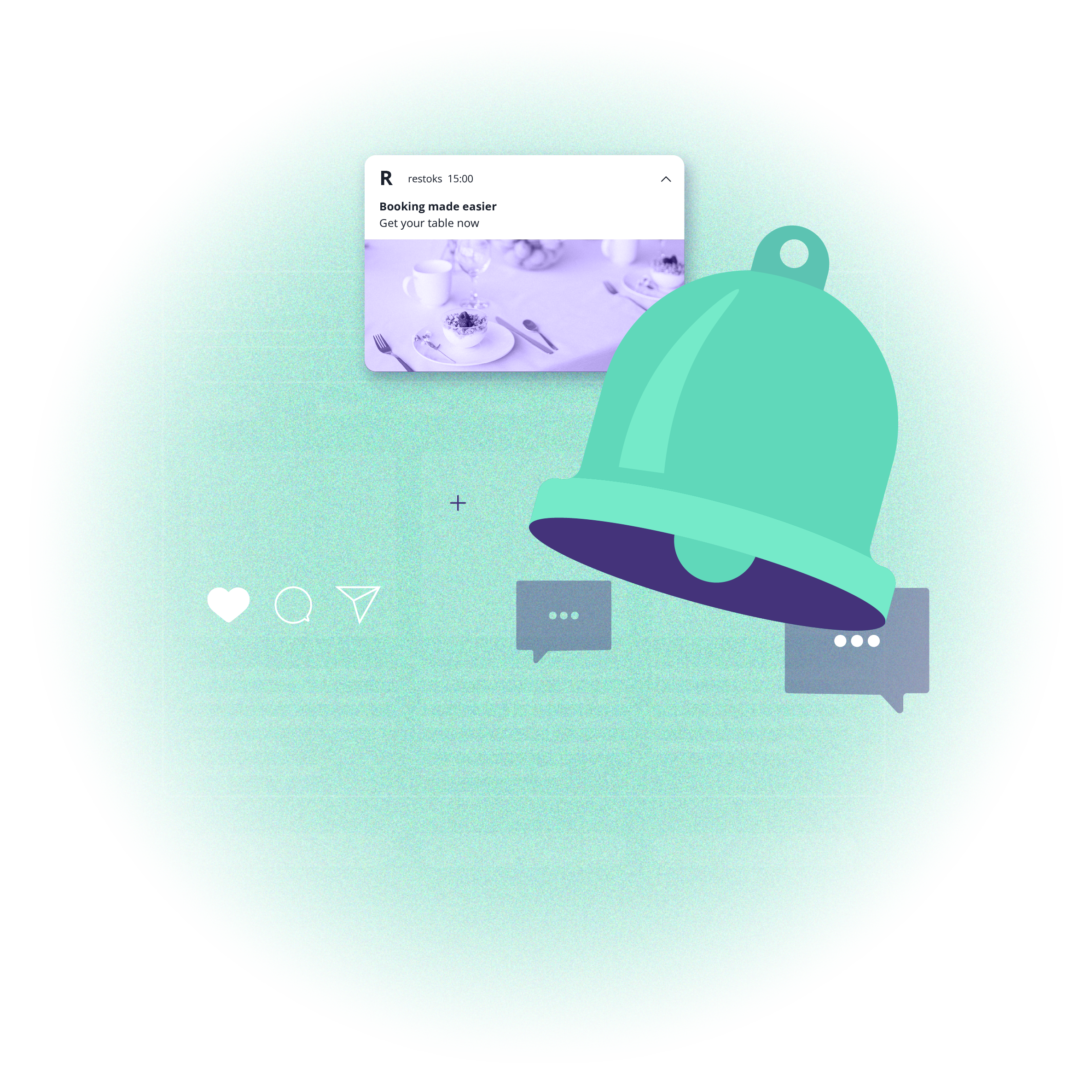12 ways for online news publishers to attract readers and retain their attention
 Aleksandra Kozioł
Aleksandra Kozioł
There are many ways to keep readers engaged and well-informed on a day-to-day basis. In this article, we won't focus on content-related matters of good journalism and research. Instead, let's talk about some marketing and communication strategies to make the audience come back for more and build a positive brand image online.
In 2020, digital publishers saw an increase in the number of readers, their engagement and even online subscriptions (16% growth according to Zuora). The optimism in the industry was palpable - and then life changed. Nowadays, online publishers are struggling to keep the engagement of their existing audience, and getting new readers is a challenge.
The paid subscription rate - soaring in the lockdown times - has reached a plateau. With news fatigue, fake news proliferation, AI slops, and audience focus capabilities dwindling, life gets hard for online news websites and magazines.
Online publishers need to answer several important questions:
How can we maintain the rate of digital subscribers?
How can we attract new readers?
How should we keep existing audience and readers that we acquired and make them return?
What can we do to keep the audience engaged?
Thankfully, you don't have to guess the answers to these questions. We've got you covered. We've made a list of over 10 different ways of attracting and retaining readers. Let's take a closer look at them:
How to attract more readers online?
What can you do to attract more people to visit your website if you are an online publisher? Here are your options:
SOCIAL MEDIA AND PERFORMANCE MARKETING
According to SmartInsights.com, 63.9% of the world's population uses social media, and the number continues to grow. The average daily usage is 2 hours and 21 minutes. However, when we take a look at the most popular social media platforms, the situation gets a bit more interesting.
There's a growing gap between generations when it comes to online preferences, with younger readers choosing TikTok, and older groups scattered between X, Facebook, Instagram, Bluesky and other platforms.
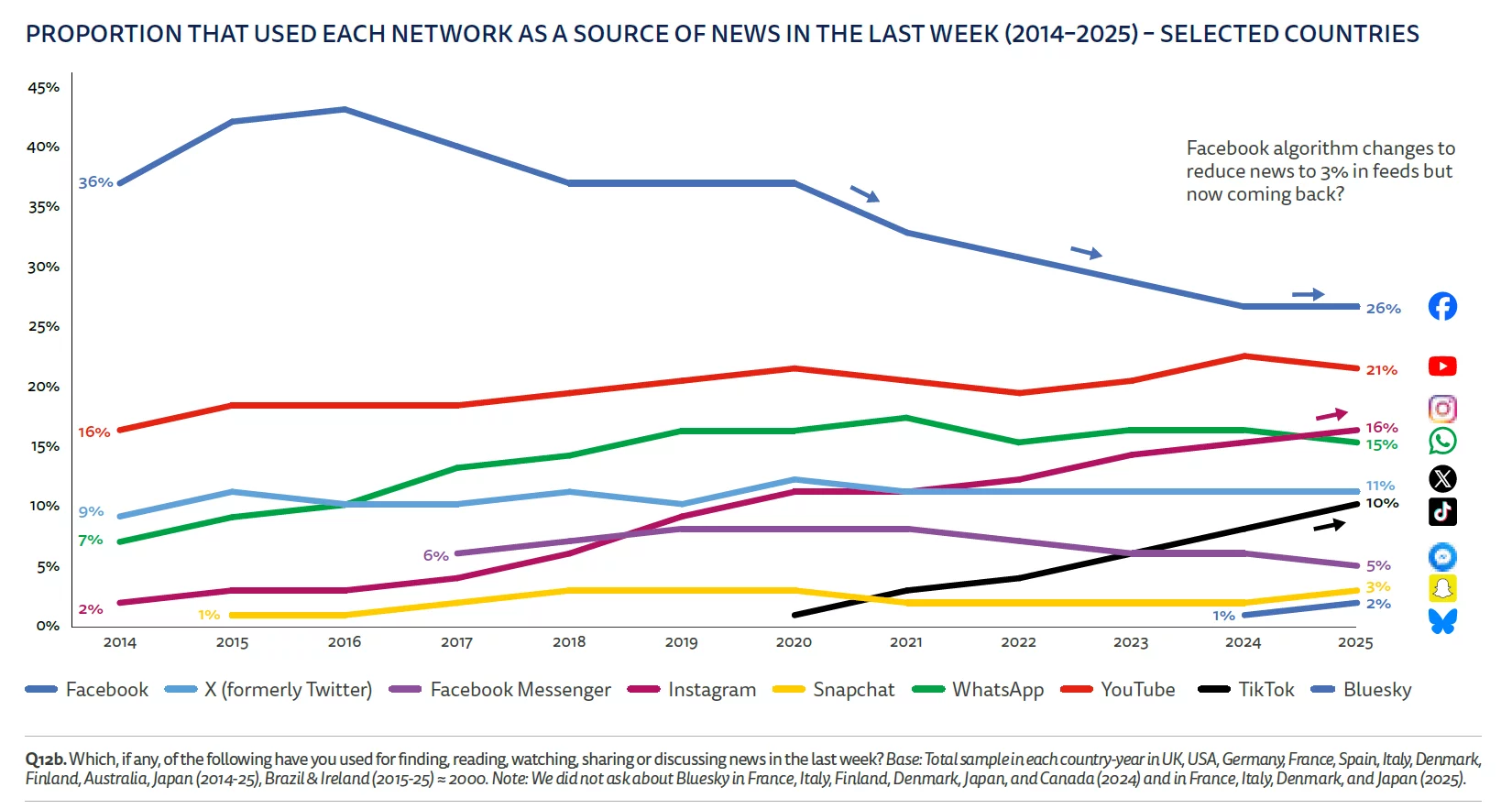
Source: 2025 Digital News Report
The main quest for online newsrooms is to find the right voice to address different reader groups on different social media platforms. This includes the content's tone of voice, the media used (is it a written article? Or maybe a short-form video reel?), and the right time and topic to publish.
Looking at the current social media trends, WhatsApp remains one of the biggest communication apps in the world. The WhatsApp Channels feature gives newsrooms one more tool at their disposal. It can also be combined with web push in the PushPushGo panel.
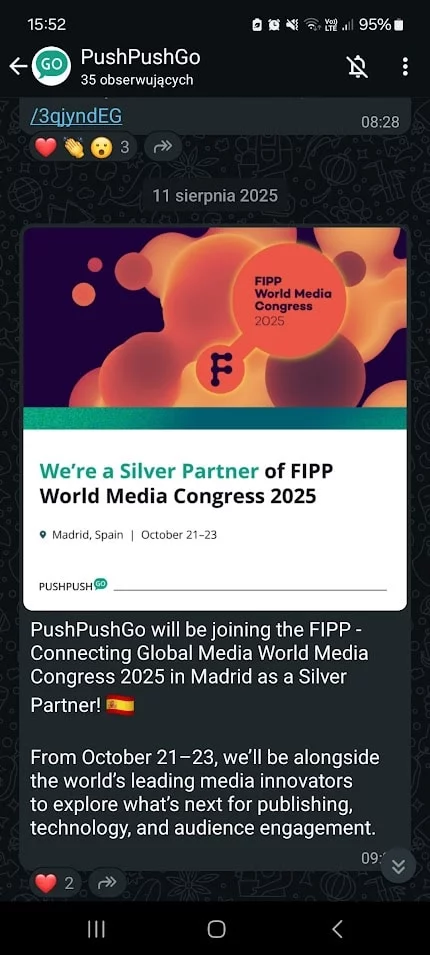
Of course, that's just a starting point. You also need to promote your profiles and content so that people know you exist. Here, performance marketing is your best bet. This technique is quick and efficient. Plus, you only pay for the result, so you don't end up wasting your marketing budget. Google Ads and Facebook Ads are the most basic examples of efficient performance marketing channels.
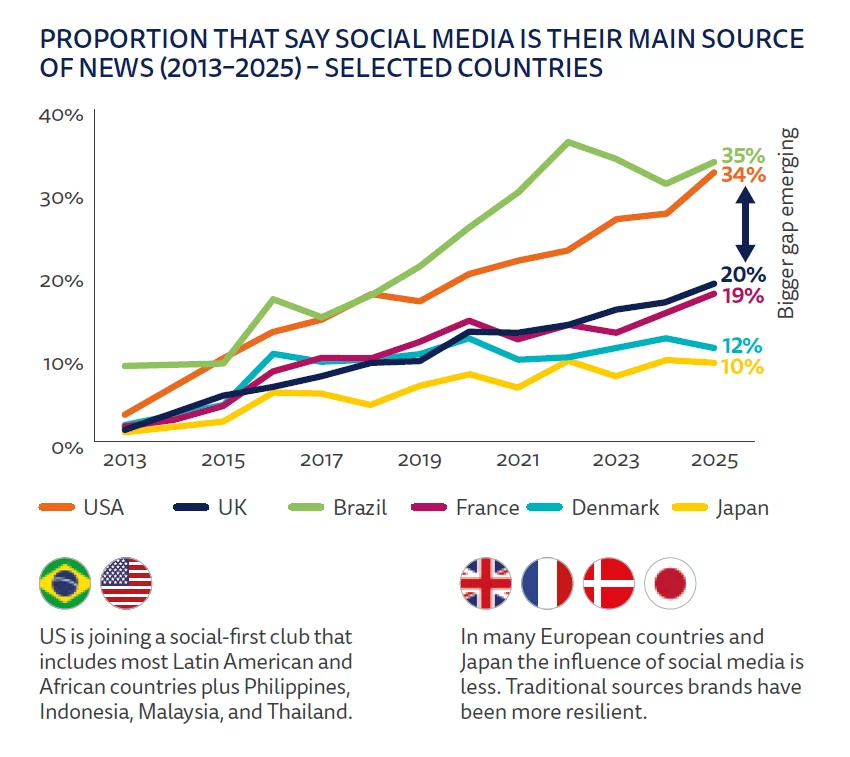
Source: 2025 Digital News Report
With Facebook Ads, you can very carefully select all the characteristics of people who will see your ads. For instance, if you are a B2B publisher, you can decide to target only entrepreneurs and experts in top management. You can determine what their interests and education should be, where they live, etc.
On the other hand, with Google Ads, you can target people who type a specific query in the search engine. Remember that Google comes with a vast ecosystem comprising many different channels, including YouTube, Gmail, and Google Maps for business.
DIVERSIFY YOUR CONTENT TYPES
To be relevant and engaging, you shouldn't limit yourself just to written content, like blog posts or articles. Today's online environment offers a lot of different options for online publishers. You can create, publish, and share content in the form of:
Podcasts
Videos
Infographics
Reports
It all depends on your niche and should be adjusted to the preferences of your target audience. Try to mix things up a bit. If you publish an article, add a good-looking infographic to make it more attractive.
If you want to present a large piece of content, deliver it in different forms so that each reader can decide how to get acquainted with it. Some users will prefer to read it, and some – listen to it when driving a car. That's where podcasts come in and save the day.
According to Reuters Institute for the Study of Journalism, 9% of the population in the countries researched for their 2025 report listened to a news podcast in the last week. The highly educated 25-34-year-olds lead in this regard.
The allure of podcasts goes far beyond the matter of convenience. With more and more content hidden behind paywall, free podcasts on YouTube are often the only source of a more detailed look at certain current issues.
SEO
A lot of people will find you through the search engine. Some of them will find you via Google Ads, but others – through organic search. In order to appear in the top results in Google (or any other search engine, for that matter), you need an SEO (search engine optimization) strategy that will comprise such elements as:
Website and code optimization
Link building (for example, you could link to all of your authors and their social media profiles and websites)
Keywords and keyphrases
If all of that works properly, you will be able to improve your visibility on Google and thus, get more visitors to your website. Here, it's immensely important to focus on subject matter-related keywords. If you run a website about winter sports, concentrate on keywords like “skiing”, “snowboarding”, “mountains”, “outdoor activity”, etc. Keywords like “magazine”, “website”, and “portal” should be in the background.
Just remember: your target audience are people, not crawl bots. In the end, your job is to attract readers, not algorithms.
OR MAYBE TRY GEO?
With the growing importance of AI, many specialists talk about a new trend - of optimizing content not only for Google's SEO algorithms but also for their Google Overview features and other LLM uses. This way, when potential readers type in their query in the search engine, the short synopsis of their answer they get comes from content on a publisher's site.
GEO, or generative engine optimization, goes beyond keywords. It's also about a specific writing style that's easy for the likes of Gemini or ChatGPT to understand and use.
Among some of the rules for a geo-optimized article or a post, there are suggestions to:
Start with a concise answer in your intro (1–2 sentences).
Use question-like headings and short paragraphs.
Add stats, expert quotes, and cite reputable sources.
Format with bullets, lists, tables, or comparison segments.
Apply schema markup like FAQ or HowTo.
Embed multimedia (images, charts, interactive tools).
Write in clear, conversational language; avoid jargon.
Update content periodically and show “last updated” tags.
Track AI citations and visibility via analytics tools.
Build your authority across platforms for stronger AI trust.
Despite the worries, Google remains a steady source of page views for publishers - so maybe the overview feature isn't as harmful as it was supposed to be.
INFLUENCER AND AFFILIATE MARKETING
How can you find the first affiliates for your website? You can turn your current readers - sort of. Many magazines, including The New York Times, allow their subscribers to gift 10 articles per month to their friends, who, in turn, can become new readers. This scheme of attracting new subscribers promotes the quality of written stories and blog posts on the site, as well as keeps specific titles and authors relevant to a wider audience.
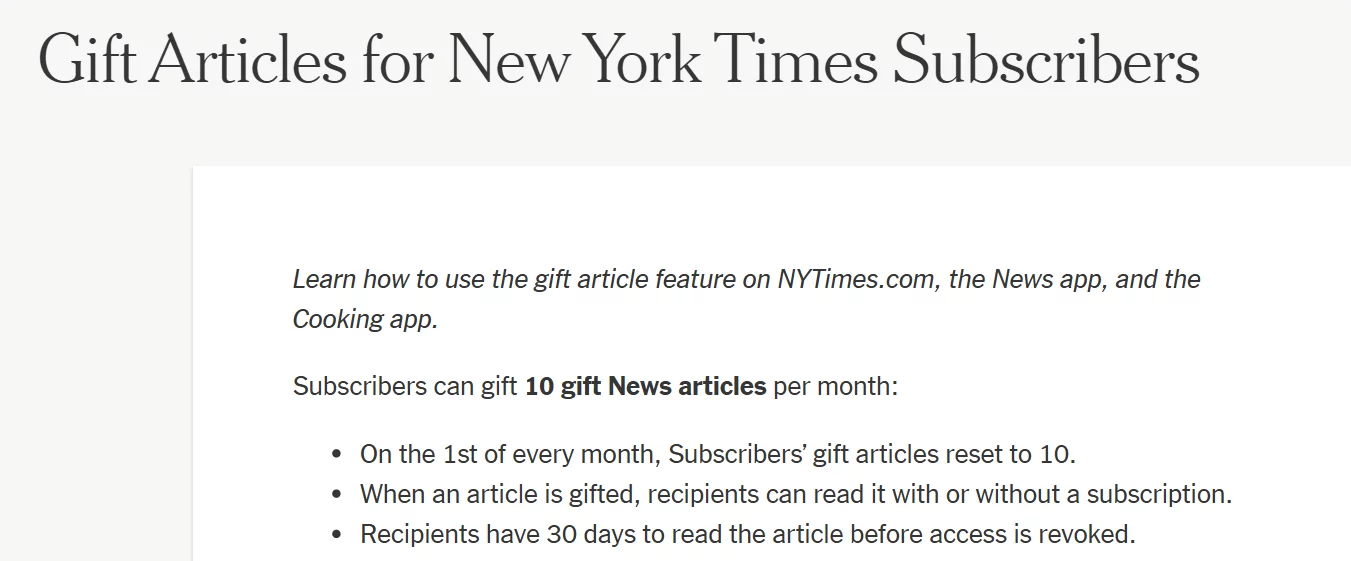
Source: New York Times
And then, there are actual, real influencers you can use. Many authors are good at their jobs, describing the world to the general public. But some people, like Joe Rogan, reach almost a godlike status. News influencers are a topic of some controversy, as many of them don't shy away from sharing their opinions on divisive political and social matters.
Some of them thrive on the discord. On the other hand, they're more and more important in the news media landscape. It was especially seen during the 2024 presidential campaign in the USA, with candidates partaking in podcasts with the most influential pundits.
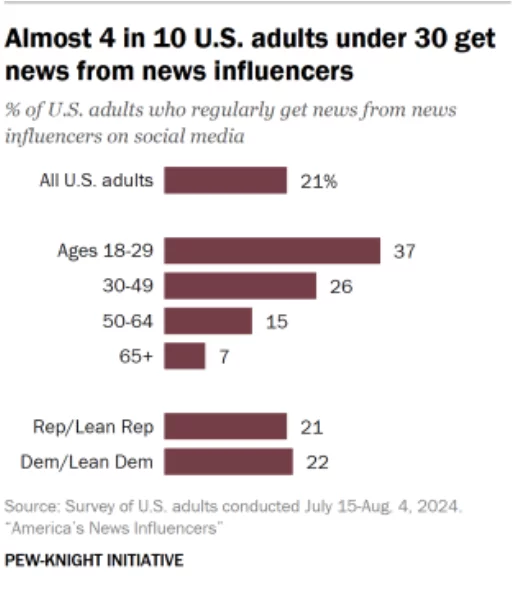
Source: PEW Research Center
till, thanks to their developed communities, these internet personalities will be able to bring a lot of new and regular readers to your business. But for the whole plan to succeed, you need exceptional content first. Potential readers - and influencers that may attract them - won't come and spend their time with mediocre texts. You ought to start there.
INTELLIGENT SUGGESTIONS VIA ONSITE NOTIFICATIONS
One way to get more traffic is by showing them content that's interesting for a particular group or even individual readers. Targeted suggestions can help you with that. For example, you can send notifications to readers currently visiting a blog post about climate change, to encourage them to learn more in the same genre and on the same subject.
The key thing to remember when using onsite notifications to further readers' engagement is to be non-obtrusive. Don't stop them from reading the text - show the notification in the corner, to catch their eye, but not irritate them.
Onsite notifications are created with information gathered during the one session - they don't collect historical data across the readers' many visits. Still, you can attract people to dive deeper into your portal, learn more about the matters important to them and then turn them into your advocates, recommending your title as a great resource for potential readers.
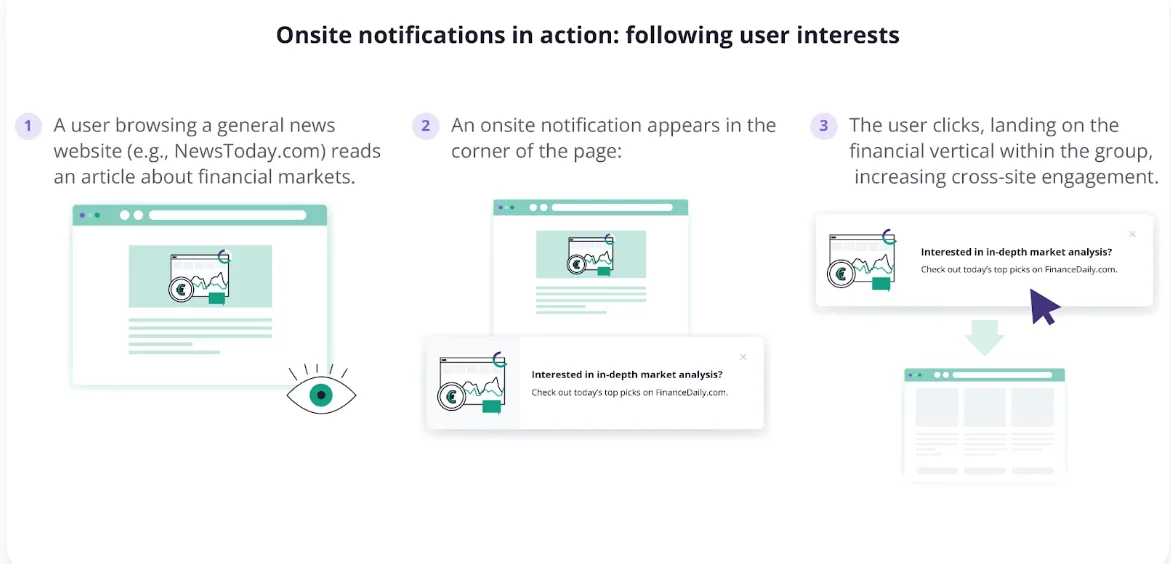
HOST EVENTS
Many niches and sectors organize regular events, both offline and online. You could host some of them or become a media patron. This way, you get quick and easy access to the desired target group. Find out what happens in your niche and contact organizers with a cooperation proposal. There's never enough good PR, so the vast majority of these companies should be interested in working with you.
How to keep your readers on the site longer?
In general, there are two boxes that you need to tick if you want to retain readers on your website:
Provide them with the content they need
Keep them engaged
Onsite notifications that we mentioned earlier are perfect for showing readers texts and posts that they might be interested in. Just think about streaming platforms such as Netflix or Spotify. They use intelligent suggestions to retain customers and keep them longer with great success. For example, Netflix's recommendation algorithm is responsible for 80% of what people watch on this platform! Take a look at this video explaining how Netflix recommendations work:
WRITE USER-FRIENDLY, ENGAGING CONTENT
That's the second element you need to consider. If your content is mediocre, boring or plagiarized, people will quickly quit your website and go elsewhere. Make sure you produce unique, high-quality content. Rely on experienced writers with broad knowledge in specific areas and work with them to produce relevant and interesting content for your target audience.
Remember, in the news media and journalism your readers will recognize a genuine piece from a content marketing format. They're also more and more media savvy, noticing AI-generated slops and blog posts meant to tick the SEO boxes, without any actual merit. In your writing process, think about your potential readers as people with their own minds and a limited time they're willing to give you. Make sure they'll come back.
ENGAGE READERS
How can you engage users? There are a few ways to achieve this goal. For starters, you need an easy-to-use comment section. People usually like to share their thoughts and opinions (so-called user-generated content).
All you have to do is provide them with a way to do just that. Create a comment section where people could post comments, reply to them, and share them via social media. Secondly, you could let users vote for specific articles and share their ideas for texts that they would like to read on your website.
You can also offer something more than just words and news - like Wordle, a New York Times game that took the world by storm and got their readers - both subscribed and occasional - to spend long hours searching for the word of the day.
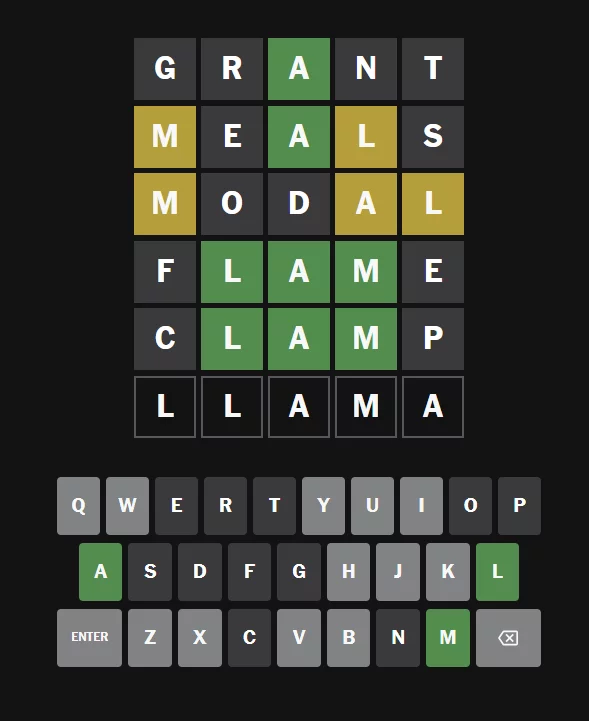
Source: New York Times
Among other effective ways to keep readers engaged are simple changes in the website's layout. Make sure your content is tagged and systematized in a way that navigates readers without any problems. Take care of the color schemes, font sizes - even with subtitles on your videos. Remember about content updates and avoid clickbait. Your main page is like your book cover - don't spoil the first impressions.
Encourage your readers to return frequently
Even if you do everything we talked about up to this point accurately, you still have some work to do. You can't assume that people will remember you after just one interaction with your brand. That's why you need additional means that will help you remind customers about your website or news portal. The omnichannel marketing strategy is the way to appeal to news audience anywhere they find it convenient.
WEB PUSH
Imagine being able to reach your readers directly, even when they're not actively browsing your site. Web push notifications make this a reality. They allow you to send timely alerts about breaking news, new content, or special features directly to a user's desktop or mobile device, cutting through the noise of overflowing inboxes and social media feeds. This capability is invaluable for re-engaging inactive users and bringing them back to your platform.
The most important aspects of web push notifications are:
It’s an opt-in solution - readers have to agree to receive them, and the process takes just two clicks - unless you add topic selection to build personalization.
The technology is browser-based, so the browser has to be open or work in the background to receive notifications. Otherwise, they work on desktops and mobile devices 0 everywhere you can get your page views via a browser.
Based on information about readers’ interactions with the website, you can personalize their experience by providing content that fits their interests.
Limited number of characters - there's not much space to write a novel. Be concise and attract your readers in about 50 characters' title and 120 characters of main text.
Of course, you can't overdo that, but such quick reminders can be very effective. See our use cases in the publishing industry. At PushPushGo, we can help you with:
Optimizing conversions of paid subscriptions
Building and developing a subscriber base
Retargeting users that visited your website in the past (to inform them about progress in stories they were following or new blog posts by authors they liked)
Targeting users based on their current location (for local stories and alerts)
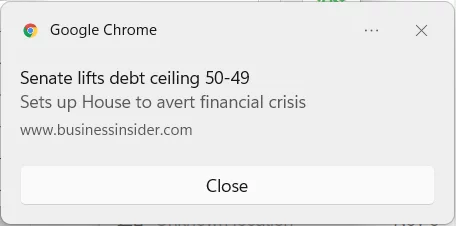
Push opt-in forms can contain an additional step in which future subscribers choose their preferred topics and categories they’re interested in. This allows us to target them right from the get-go, without waiting for first-party cookies to follow them to their favorite content.
You can also use send push notifications linked with your RSS feed. It's an excellent solution that allows users to get updates (e.g., about new stories) quickly and conveniently, for example, via email or an internet browser. Now, newsrooms can also benefit from the RSS to facilitate publishing their web push mass campaigns.
Still, there are other outlets - and more ways to attract your audience.
NEWSLETTERS
If you have a base of subscribers with email addresses, you can use it to send regular newsletters. What should be in such a newsletter? Publishers frequently mention the most interesting/newest posts and articles, share industry news, and inform about special offers.
Such a newsletter should be sent regularly but not too often (you don't want to tire your subscribers with these messages). Once a week seems like an optimal frequency. Of course, provided that you have something to write about. Sending a boring and repetitive newsletter just because you feel that it's time is not a good strategy.
NEWS APPS AND MOBILE PUSH
News portals on websites aren't the only way for readers to interact with new stories. Since users are spending more and more time consuming content on their smartphones, mobile apps are gaining traction as the more convenient tool to communicate.
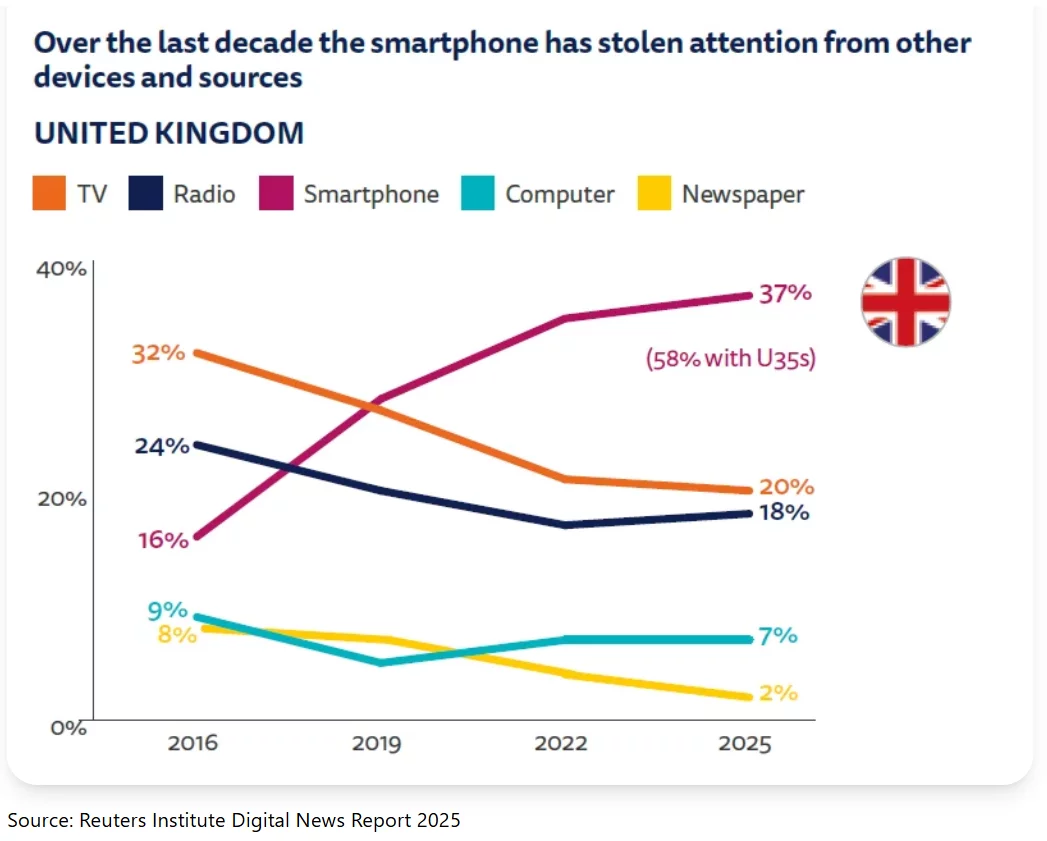
Source: 2025 Digital News Report
That's a step in the right direction - mobile marketing strategy is on the rise as the print version of magazines is getting extinct, this is the way for readers to have their favorite titles at a hand's reach. The appeal of a well-designed app is clear to both the audience and the authors. Still, there's a challenge in driving return visits.
The key to build a good communication strategy, primarily using mobile push notifications. The idea of web mobile push notifications is almost identical to web push, with differences concerning character limits and technicalities.
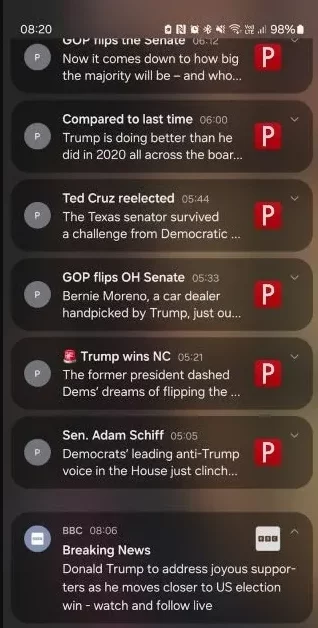
And just as a main page can be seen as a book cover - a means to judge the contents of the portal - a mobile push notification can be seen as a first page of a newspaper. It has to be clear, concise and offer clear benefits in clicking the notification. And the content of the story? It needs to be good enough so that the audience members won't delete the app or block the notifications permanently.
In one of our previous blog posts, we focused on the readers' expectations regarding mobile push.
Summary
As you can see, there are a lot of ways for you to reach and retain readers on your website. Test different ideas and stick to those that work best - as long as you create content that works.
At the heart of it all is the user. The most effective strategies are those that allow users to interact with the news on their own terms, choosing what content to receive, how they receive it, and when. Empowering your audience in this way builds not only engagement but also loyalty, laying the foundation for a stronger, more sustainable relationship between publisher and reader.
.We sincerely encourage you to try web and mobile push - and other tools in PushPushGo's arsenal. In our latest ebook, we describe a step-by-step strategy for building readers' engagement and keeping them hooked on stories and titles they enjoy. You can find even more resources on our blog.
And if you're ready to talk shop, we'll be there for you - contact us.

Content Specialist @PushPushGo
Editor and writer. She is interested in media and new technologies.
Try PushPushGo to engage and connect with your audience.
Create an account and start testing!
